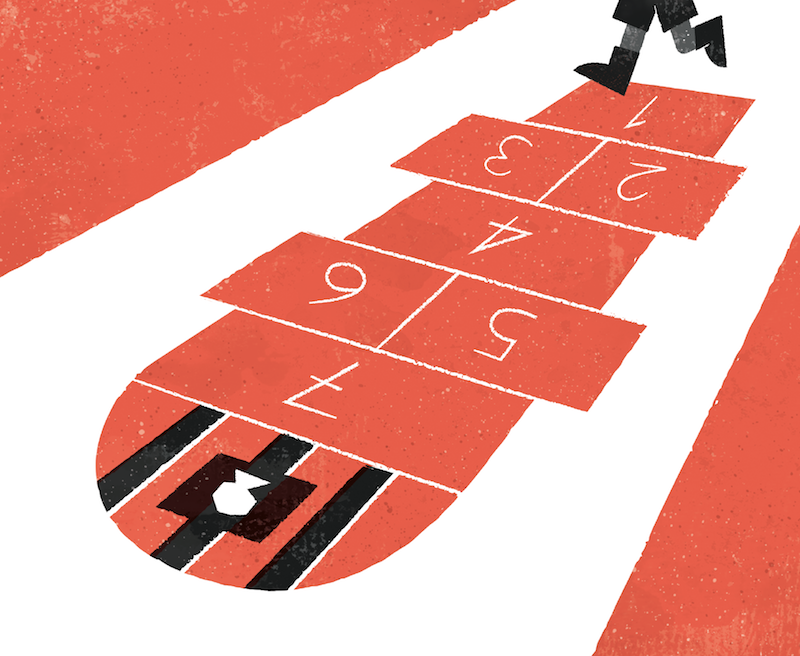Secondary menu
Immigration Detention Harms Canadian Families
28 February, 2017
Yolanda Song (3L)

Illustration by Ryookyung Kim. Image courtesy of International Human Rights Program.
When 8-year-old Alicia visits her mother Selena at the immigration detention facility in Toronto, they speak through phones on either side of a plexiglass partition. There are no openings through which she can hold her mother’s hand as she asks, “Mommy, why do they want to separate us?”
Selena told me this through fits of tears when IHRP Senior Fellow Hanna Gros, Director Samer Muscati, and I spoke with her last November at the Toronto immigration detention centre. Selena and Alicia’s story, as well as those of five other families, is included in the IHRP’s new report entitled Invisible Citizens: Canadian Children in Immigration Detention. The report shows that Alicia is just one of the hundreds of Canadian children who have been hurt by Canada’s immigration detention practices. Between 2011 and 2015, at least 227 Canadian children were housed in immigration detention with their parents. Many others, like Alicia, are separated from their detained parents and left in the care of relatives, friends, or child protection agencies.
Canadian children are affected by immigration detention when their migrant parents are arrested by the Canada Border Services Agency (CBSA). This generally occurs when CBSA officers believe that the parents will not comply with immigration proceedings and pose a flight risk. Detained parents are given a perverse ultimatum: live with their children in detention, or separate from them. Families face this impossible choice even though, in the vast majority of cases, the parents do not pose a danger to the public and have not been charged with any crime.
Unsurprisingly, detention is no place for children. An IHRP report released in September 2016, entitled “No Life for a Child”: A Roadmap to End Immigration Detention of Children and Family Separation, found that life in detention is “woefully unsuited for children.” Children who are detained for even brief periods can suffer serious psychological harm, including symptoms of post-traumatic stress, depression, and anxiety that may persist long after the child is released. In a letter to Prime Minister Justin Trudeau, one Canadian child described detention as a “cage”.
Family separation is no better. Medical evidence indicates that children who are separated from their detained parents experience intense and lasting emotional distress. In the week following her mother’s arrest, Alicia would wake up crying in the middle of the night. She no longer wanted to play during recess. “Everything is different,” Selena said.
For Canadian children affected by immigration detention, mechanisms for recourse are sorely lacking. The Immigration and Refugee Protection Act does not allow for the detention of Canadian citizens. Because of this, CBSA does not issue detention orders against Canadian children. Instead, CBSA treats Canadian children in immigration detention as “guests” of their detained parents. Canadian children who are “guests” cannot legally challenge their placement in detention because they are not “detained”—in theory, they have the freedom to leave the facility at any time, without their parents. The artificiality of this freedom is abundantly clear when one considers that, between 2011 and 2015, 85% of Canadian children in the Toronto detention centre were younger than six years old, and nearly two-thirds were younger than two.
Moreover, children who are separated from their detained parents do not have access to any procedures for addressing the damage that separation has done to them. Their parents undergo regular detention review hearings, in which the quasi-judicial Immigration Division determines whether their continued detention is justified. However, adjudicators do not adequately consider the interests of detainees’ children. Selena said that the adjudicator at her detention review “didn’t mention Alicia at all.”
Last August, Minister of Public Safety and Emergency Preparedness Ralph Goodale announced the beginning of reforms to the immigration detention regime, with a particular focus on ending child detention. In doing so, Minister Goodale must also pay diligent attention to families like Alicia’s that are torn apart by immigration detention. To effectively address the impact of these practices on children, the government must recognize that options other than detention and separation are available. Authorities should implement alternatives to detention that allow children to live with their parents in the community. These include reporting obligations, cash bonds, and community supervision.
These community-based alternatives alleviate the terrible mental health consequences of detention and family separation, and allow for the greater protection of children’s rights to freedom, health, and family unity. They do this while continuing to ensure that individuals will appear for immigration proceedings. A 2011 UNHCR study found that, around the world, approximately 90 percent of asylum-seekers cooperate with authorities in immigration procedures when they are given alternatives to detention. Notably, the study identified that compliance is higher when authorities treat individuals with dignity, communicate their rights and obligations clearly, and provide adequate material, legal, and case management support. As a final benefit, community-based alternatives cost a mere fraction of the average $21.5-million that the government spends on immigration detention centres each year (based on data from 2010-2014).
Canada must do more for Canadian families like Alicia and Selena’s. As our immigration detention system undergoes the reform it so desperately needs, policy-makers must focus on the development of viable community-based alternatives to detention that will be regularly implemented by authorities. Anything less, and we simply swap out cages for plexiglass partitions.
